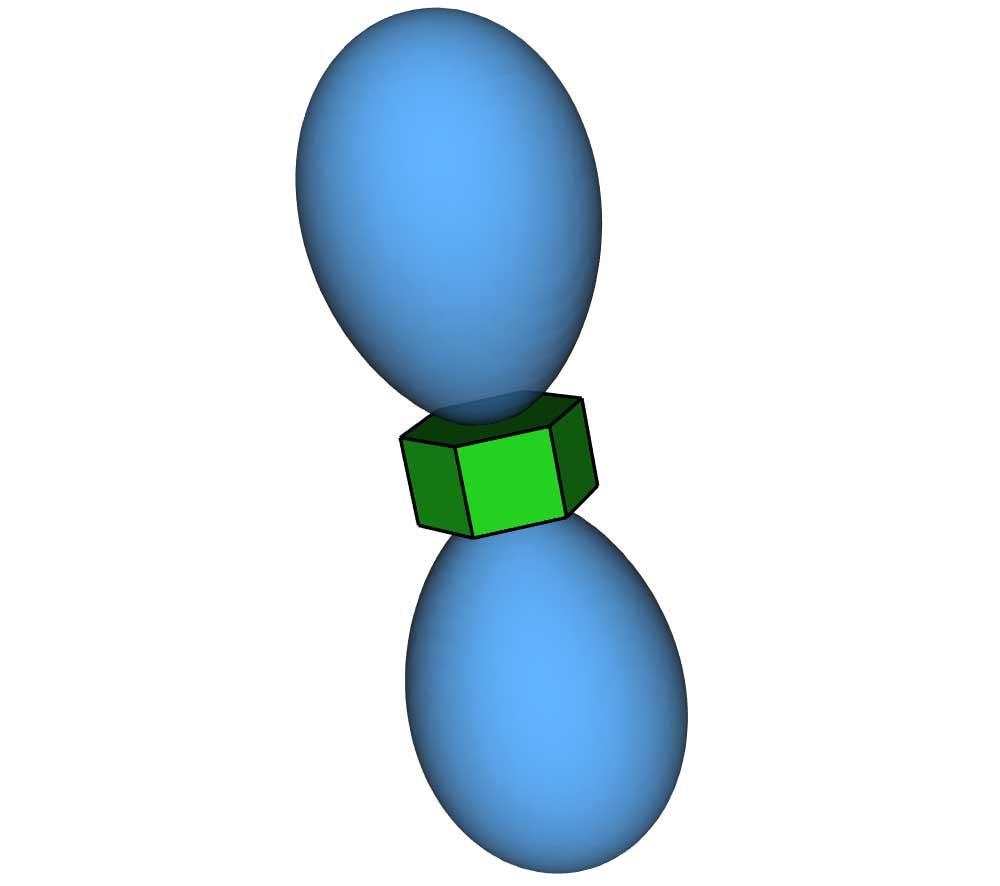Entropy, a physical property frequently explained as “disorder,” is shown as an architect of order with a new bonding theory formulated at the University of Michigan and reported in the Proceedings of the National Academy of Sciences.
 Nanoparticles in a prism orbital shape. The density of the pseudoparticles around nanoparticle shapes resembles the electron density in the electron orbitals of atoms. Image credit: Thi Vo, Glotzer Group, University of Michigan.
Nanoparticles in a prism orbital shape. The density of the pseudoparticles around nanoparticle shapes resembles the electron density in the electron orbitals of atoms. Image credit: Thi Vo, Glotzer Group, University of Michigan.
Engineers seek to use nanoparticles to form designer materials, and the new theory can help facilitate efforts to make nanoparticles develop into beneficial structures. The theory explains previous results investigating the formation of crystal structures by space-restricted nanoparticles, allowing entropy to be measured and utilized in future efforts.
Interestingly, the set of equations that control nanoparticle interactions because of entropy mirror those that illustrate chemical bonding. Sharon Glotzer, the Anthony C. Lembke Department Chair of Chemical Engineering, and Thi Vo, a postdoctoral scientist in chemical engineering, offer insight into their new theory.
What is Entropic Bonding?
Entropic bonding can be defined as a way of explaining how nanoparticles interact to develop crystal structures. It is comparable to the chemical bonds created by atoms. But in contrast to atoms, there are no electron interactions binding these nanoparticles together. Rather, the attraction occurs due to entropy.
Frequently, entropy is related to disorder, but it is truly about options. When nanoparticles are crammed together and options are less, it turns out that the most probable arrangement of nanoparticles can be a specific crystal structure. That structure provides the system with the most options, and consequently the highest entropy. Large entropic forces occur when the particles are crammed together.
By performing wide-ranging studies of particle shapes and the crystals they create, Glotzer’s group discovered that not only the shape can be changed, but also the directionality of those entropic forces that decide the creation of these crystal structures can be changed. That directionality mimics a bond, and since it is stimulated by entropy, the researchers define it as entropic bonding.
Why is This Important?
Entropy’s contribution to forming order is frequently ignored when engineering nanoparticles for self-assembly, but that is wrong. If entropy is aiding a system to organize itself, then one need not have to engineer overt attraction between particles — for example, using DNA or other sticky molecules — with as strong an interaction as possible. With their new theory, the two researchers can quantify the strength of those entropic bonds.
While the researchers were aware that entropic interactions can be directional like bonds, their breakthrough is that those bonds can now be described with a theory that meticulously matches the theory that one would note down for electron interactions in real chemical bonds. That is insightful, as well as amazing.
From a mathematical standpoint, it places chemical bonds and entropic bonds in the same league. This is essentially important for the understanding of matter and practically vital for creating new materials.
Electrons are the Key to Those Chemical Equations. But How Was this Achieved When No Particles Mediate the Interactions Between the Nanoparticles
Entropy is linked to the free space in the system, but for years, Glotzer was not aware of how to count that space. The crucial insight from Thi Vo was that that space could be counted using fictitious point particles, which then gave the researchers the mathematical analog of the electrons.
The pseudoparticles travel around the system and fill in the gaps that are hard for another nanoparticle to fill — this was referred to as the excluded volume surrounding each nanoparticle. As the nanoparticles became more arranged, the excluded volume surrounding them became smaller, and the concentration of pseudoparticles in those regions increased. The entropic bonds form where that concentration is the highest.
In crammed settings, the entropy lost by increasing the order is compensated by the entropy gained by decreasing the excluded volume. Consequently, the configuration with the highest entropy will be the one where pseudoparticles take up the least space.
The research received funding from the Simons Foundation, Office of Naval Research and the Office of the Undersecretary of Defense for Research and Engineering. It depended on the computing resources of the National Science Foundation’s Extreme Science and Engineering Discovery Environment.
Glotzer is also the John Werner Cahn Distinguished University Professor of Engineering, the Stuart W. Churchill Collegiate Professor of Chemical Engineering, and a professor of material science and engineering, macromolecular science and engineering, and physics at U-M.
Journal Reference:
Vo, T. & Glotzer, S. C. (2022) A theory of entropic bonding. Proceedings of the National Academy of Sciences. doi.org/10.1073/pnas.2116414119.